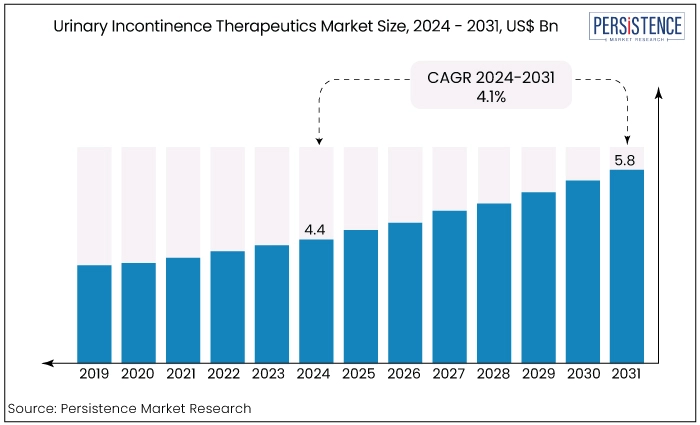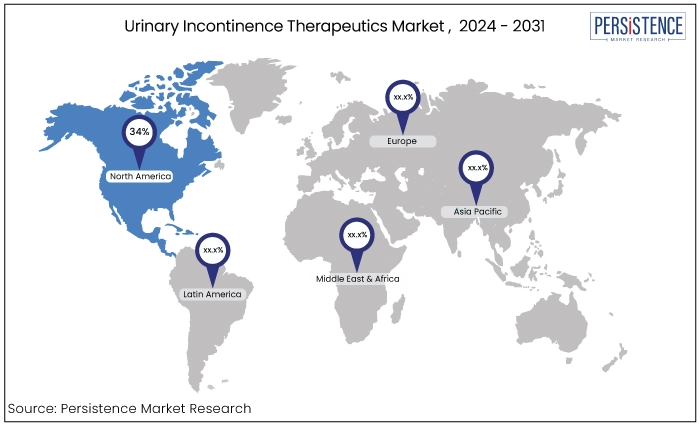Urinary Incontinence Therapeutics Market
Industry: Healthcare
Published Date: September-2024
Format: PPT*, PDF, EXCEL
Delivery Timelines: Contact Sales
Number of Pages: 170
Report ID: PMRREP34774
The urinary incontinence therapeutics market is estimated to increase from US$4.4 Bn in 2024 to US$5.8 Bn by 2031. The market is projected to record a CAGR of 4.1% during the forecast period from 2024 to 2031. In 2023, the U.S. urinary incontinence therapeutics market captured a substantial portion of the North America market, driven by the widespread prevalence of the condition, which affects millions of adults.

Key Highlights of the Market
|
Market Attributes |
Key Insights |
|
Market Size (2024E) |
US$4.4 Bn |
|
Projected Market Value (2031F) |
US$5.8 Bn |
|
Global Market Growth Rate (CAGR 2024 to 2031) |
4.1% |
|
Historical Market Growth Rate (CAGR 2019 to 2023) |
3.8% |
|
Region |
Market Share in 2024 |
|
North America |
34% |
North America is projected to lead the urinary retention therapeutics market, capturing 34% of the market share by the end of 2024. This growth is driven by the early adoption of new technologies, a large patient population with urinary disorders, and the easy availability of attractive medical reimbursement options in the U.S. and Canada.
Strategies such as research and development, mergers & acquisitions, and new product launches by leading companies are boosting market growth. For instance, in February 2020, Atlantic Therapeutics announced that the U.S. FDA approved 'INNOVO,' a wearable, non-invasive device for treating stress urinary incontinence in adult women, available over-the-counter. These factors are expected to support the market’s growth in North America.

|
Category |
Market Share in 2024 |
|
Type - Stress Incontinence |
40% |
By type of incontinence, the stress urinary incontinence segment is anticipated to hold a 40% market share by the end of 2024, leading the urine retention therapeutics market. The increase in stress urinary incontinence cases among women is the reason for the surge.
Approximately 50% of women who experience urine incontinence also report having stress incontinence symptoms, according to epidemiological studies on the condition in women. Research has also revealed that after prostate surgery, men's rates of stress urine incontinence vary from 2% to 70%. During the anticipated time, these variables are probably going to drive the segment's expansion.
|
Category |
Market Share in 2024 |
|
End User - Retail Pharmacy |
57% |
Retail pharmacy dominates the industry accounting for 57% market share in 2024. The retail pharmacies' extensive global reach and established market dominance are a result of their widespread availability and longevity.
Retail pharmacies provide convenience for people looking to purchase UI drugs because they are widely accessible to the public. This accessibility is essential particularly for elderly people who account for a large proportion of patients with incontinence. When patients are managing their use of over-the-counter (OTC) drugs and prescribed therapy, retail pharmacies are frequently their initial point of contact.
The increasing prevalence of urinary incontinence (UI) is due to the factors such as urinary tract infections, weakened pelvic floor muscles, pregnancy, childbirth, and post-surgery in men following prostate removal. These issues are expected to contribute to the rise of UI symptoms and fuel the growth of urinary retention therapies during the forecast period.
The increasing incidence of urological disorders and the development of advanced incontinence devices are projected to boost the urinary retention device market. The demand for minimally invasive procedures, along with an aging population more susceptible to urological issues, is also anticipated to drive market growth.
Many patients with urinary incontinence are shifting from traditional to advanced treatment methods benefiting market expansion. The increasing risk of related urological disorders is expected to further support the market's growth trajectory.
The increasing incidence particularly in older adults and post-surgical patients contributed significantly to market expansion. Development of minimally invasive treatments such as neuromodulation devices and botulinum toxin therapies gained traction in the past years. This has significantly contributed to the market's expansion. The market expanded at a CAGR of 3.8%, indicating steady growth during that period.
Development of minimally invasive treatments, such as neuromodulation devices and botulinum toxin therapies gained traction during this period. The market will benefit from a heightened focus on female urinary incontinence with companies investing in new products targeting women.
The urinary incontinence therapeutics market overview has shown consistent growth over the years, and its upward trajectory is expected to continue in the future. The market is projected to capture a CAGR of 4.1% during the forecast period from 2024 to 2031.
Growing Prostate Cancer Cases
The rising number of prostate cancer cases is boosting the growth of the urinary incontinence therapeutics. market. There is also increasing demand for advanced, minimally invasive over-the-counter (OTC) devices and wearables, which is pushing research and development in urinary retention devices.
Medical technology companies are actively seeking FDA approval for their next-generation devices designed to treat stress incontinence, particularly in women. These developments are expected to fuel market growth in the coming years.
Rising Awareness and Diagnostics Boost Market
Rising awareness about urinary incontinence along with improved diagnostic methods is significantly driving the urinary incontinence therapeutics market. Public health campaigns and educational programs have led to increased knowledge about the condition encouraging more individuals to seek medical help.
With advanced diagnostic tools, healthcare providers can now identify and classify incontinence types more effectively leading to better-targeted treatments. This heightened awareness and diagnosis particularly among old adults and women are increasing the demand for both pharmacological and non-pharmacological therapies contributing to the overall growth of the market.
Challenges Limiting Growth
The urinary incontinence therapeutics market faces challenges due to a lack of awareness about new advancements in treatment options and the complications that can arise after using these devices.
The increasing cost of treatment and the vulnerability of the aging population are factors that reduce demand for urinary retention medications. The market's growth is further hindered by patients opting for alternative therapies. Another obstacle is the growing number of people with incontinence who are unaware of their condition, which limits the market's potential expansion during the forecast period.
Increasing Cost of Urinary Incontinence Therapies
The increasing cost of urinary incontinence therapies can make it difficult for patients to afford treatment. As the price of medications and devices rises, some individuals may hesitate to seek help or continue with prescribed treatments. This financial burden can lead to fewer people accessing the necessary care, which impacts their quality of life.
The high expense is a significant barrier preventing them from exploring or sticking with effective therapies, and ultimately limiting their treatment options and market growth for these products.
Innovative Product Development in Urinary Incontinence
Innovative product development offers great opportunities for companies in the market. By focusing on new technologies like smart wearables, less invasive treatments, and customized therapies, companies can meet patient needs and stand out from competitors.
Creating advanced solutions with better results and few side effects can boost market growth. Investing in research to develop new products that cater to different patient needs can open new market segments and improve patient satisfaction leading to future success and leadership in the market.
There are many leading industry players in the fiercely competitive market. To treat urinary retention disease, these players are developing cutting-edge new delivery methods. The market for urinary incontinence therapeutics is anticipated to grow as a result.
Pfizer Inc., AbbVie Inc., Astellas Pharma Inc., Johnson & Johnson, Viatris Inc., and Teva Pharmaceutical Industries Ltd. are the leading companies in the market. Prominent industry participants tend to employ inorganic growth tactics such as partnerships, acquisitions, mergers, and collaborations to enhance their range of products. The global market for urinary retention therapies is expected to benefit from this.
Recent Developments in the Urinary Incontinence Therapeutics Market
|
Attributes |
Details |
|
Forecast Period |
2024 to 2031 |
|
Historical Data Available for |
2019 to 2023 |
|
Market Analysis |
US$ Billion for Value |
|
Key Regions Covered |
|
|
Key Market Segments Covered |
|
|
Key Companies Profiled |
|
|
Report Coverage |
|
|
Customization & Pricing |
Available upon request |
By Type
By Drug Class
By End User
By Region
To know more about delivery timeline for this report Contact Sales

The market is estimated to increase from US$4.4 Bn in 2024 to US$5.8 Bn by 2031.
Rising awareness and diagnosis rates is a key driver for market growth.
A few of the key market players are Pfizer Inc., AbbVie Inc., Astellas Pharma Inc., Johnson & Johnson, Viatris Inc.
The market is projected to record a CAGR of 4.1% during the forecast period from 2024 to 2031.
Shift towards personalized medicine in the urinary incontinence therapeutics industry presents a significant opportunity.